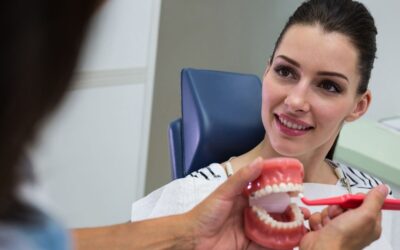Calcium deposits on teeth, also known as tartar or dental calculus, are a common yet preventable dental issue. These deposits are a hardened form of plaque that forms when the minerals from saliva mix with the plaque buildup on your teeth. If left untreated, calcium deposits can lead to gum disease, tooth decay, and an overall poor appearance of your smile. While professional cleanings by a dentist are the most effective way to remove heavy tartar, there are several ways to manage and even remove calcium deposits at home. This article will guide you through the process, sharing simple yet effective techniques, tools, and habits that can help you maintain a clean, healthy mouth without the need for costly dental visits.
Understanding how calcium deposits develop on your teeth is essential to effectively address and prevent them.
Calcium deposits, or tartar, start as plaque, a sticky substance that forms on teeth after eating or drinking. Plaque is made up of food particles, bacteria, and saliva. When plaque isn’t removed through regular brushing and flossing, it hardens into tartar. The minerals found in saliva, particularly calcium, contribute to this hardening process. Over time, tartar can lead to visible stains on teeth and potential oral health issues such as gum disease, bad breath, and tooth decay.
To prevent the formation of calcium deposits, it’s crucial to understand that plaque is the initial culprit. Preventing plaque buildup through good oral hygiene is your first defense against tartar.
Effective Home Remedies to Remove Calcium Deposits
If you already have calcium deposits on your teeth, these home remedies can help reduce their buildup and maintain cleaner teeth.
Baking Soda and Water
Baking soda is a natural abrasive that can gently scrub away surface stains and buildup. It works by breaking down the plaque and helping prevent tartar formation. To use, mix a teaspoon of baking soda with a small amount of water to create a paste. Use your toothbrush to apply the paste and gently brush your teeth. Be careful not to scrub too aggressively to avoid damaging your enamel.
Apple Cider Vinegar (ACV)
Apple cider vinegar is another effective home remedy for removing calcium deposits due to its acidic nature, which helps break down tartar. To use, dilute apple cider vinegar with water (1 part vinegar to 2 parts water) and rinse your mouth with the mixture for about 30 seconds. Avoid using this solution too frequently as the acidity can erode enamel if used excessively.
Coconut Oil Pulling
Coconut oil pulling is an ancient practice that involves swishing oil in your mouth for 15–20 minutes. It’s believed to help reduce plaque buildup, bacteria, and overall oral inflammation. The lauric acid found in coconut oil has natural antibacterial properties, making it a great option to help combat plaque and tartar buildup. To use, simply swish a tablespoon of coconut oil around your mouth for 15–20 minutes and then spit it out.
Hydrogen Peroxide
Hydrogen peroxide has natural whitening and antibacterial properties that can help eliminate tartar. Dilute hydrogen peroxide with an equal amount of water and use it as a mouthwash. You can also mix it with baking soda to form a paste for brushing your teeth. Be sure to avoid swallowing hydrogen peroxide and to rinse your mouth thoroughly afterward.
Lemon Juice
Lemon juice is a natural acid that can help remove tartar. It’s often combined with baking soda to create a powerful paste that works to scrub away buildup. To use, mix one tablespoon of lemon juice with baking soda and brush your teeth with the paste. Be sure to rinse your mouth afterward to prevent acidity from eroding your enamel.
The Role of Proper Oral Hygiene in Preventing Calcium Deposits
Maintaining a consistent oral hygiene routine is essential to preventing calcium deposits from forming on your teeth.
Proper oral hygiene is the foundation for preventing calcium deposits. Here are some essential habits to adopt:
Brush Twice a Day
Brushing your teeth at least twice a day is a fundamental step in removing plaque before it can harden into tartar. Use fluoride toothpaste and a soft-bristled toothbrush to gently scrub your teeth. Make sure to brush for at least two minutes each time and pay attention to all surfaces of your teeth.
Floss Daily
Flossing is essential for cleaning between your teeth where a toothbrush can’t reach. Flossing removes food particles and plaque, which can contribute to tartar buildup. It’s best to floss at least once a day, ideally before bedtime, to prevent plaque from sitting on your teeth overnight.
Use Antibacterial Mouthwash
An antibacterial mouthwash can help kill bacteria in your mouth and reduce plaque buildup. Choose a mouthwash that contains fluoride or antiseptic properties to target the bacteria that contribute to tartar. Rinsing with mouthwash is a simple way to enhance your oral hygiene routine and ensure your mouth stays fresh.
Avoid Smoking
Smoking is a major contributor to plaque and tartar buildup. It also stains teeth and can increase your risk of gum disease. Quitting smoking can significantly improve your oral health and reduce the likelihood of calcium deposits forming on your teeth.
The Best Tools for Home Teeth Cleaning
In addition to natural remedies, there are specific tools designed to help you remove calcium deposits and maintain a clean mouth at home.
Electric Toothbrush
Electric toothbrushes are more efficient than manual brushes at removing plaque and tartar. They are designed to make brushing easier and more effective, offering up to 40,000 brush strokes per minute. Electric toothbrushes often have built-in timers to ensure that you brush for the full two minutes recommended by dentists.
Tartar Scrapers
Tartar scrapers are tools specifically designed for removing tartar buildup. They are available in both manual and electric versions and can be used at home to gently scrape away hardened plaque. However, it’s essential to use these tools carefully to avoid damaging your tooth enamel.
Water Flossers
Water flossers, such as the popular Waterpik, use pressurized water to remove food particles and plaque from between your teeth. These devices are particularly helpful for people with braces or those who struggle with traditional flossing. Regular use of a water flosser can help prevent plaque and calcium deposits from forming.
Preventing Calcium Deposits in the Future
After removing existing calcium deposits, it’s important to adopt long-term strategies to prevent them from returning.
Stay Hydrated
Drinking plenty of water throughout the day helps to wash away food particles, bacteria, and saliva from your mouth. It also promotes the production of saliva, which contains natural enzymes that help prevent plaque buildup. Aim to drink water consistently to keep your mouth clean and healthy.
Limit Sugary and Acidic Foods
Foods high in sugar and acidity can contribute to plaque buildup and increase your risk of tartar. Sugary snacks and drinks feed the bacteria in your mouth, while acidic foods, such as citrus and soda, can erode tooth enamel. Limiting these foods can help keep your teeth cleaner and healthier.
Use Fluoride Products
Fluoride helps to strengthen tooth enamel and prevent the buildup of plaque. Using fluoride toothpaste and mouthwash can protect your teeth from future calcium deposits. Fluoride helps to remineralize your teeth and makes them more resistant to decay.
Visit the Dentist Regularly
Even with the best home care routine, it’s essential to see a dentist regularly for professional cleanings. Dentists can remove tartar that has built up over time and can spot early signs of oral health issues. Regular checkups are essential for maintaining long-term oral health.
FAQs:
Can I remove calcium deposits on my teeth at home?
Yes, there are several methods, such as using baking soda, apple cider vinegar, and coconut oil pulling, that can help manage calcium deposits at home. However, a dentist’s professional cleaning is the most effective for stubborn deposits.
How often should I brush to avoid calcium buildup?
Brushing your teeth twice a day is essential to prevent plaque buildup, which eventually hardens into tartar. Flossing daily also helps to remove plaque from hard-to-reach places.
Is coconut oil pulling effective for removing calcium deposits?
Yes, coconut oil pulling can help remove plaque and bacteria, reducing the risk of calcium buildup. However, it’s best used as a supplementary measure, not a replacement for regular brushing.
What happens if I leave calcium deposits on my teeth?
If left untreated, calcium deposits can lead to gum disease, cavities, and tooth decay. It can also make your teeth look yellow or stained.
Can a tartar scraper help with calcium deposits at home?
Yes, tartar scrapers are designed to remove tartar. However, they should be used gently and with care to avoid damaging your enamel. It’s also a good idea to consult with a dentist on how to use them properly.
Conclusion
Calcium deposits on teeth are a common issue that can significantly impact both your oral health and appearance. While professional cleanings are the most effective way to remove tartar, there are several natural remedies and tools you can use at home to manage or even eliminate calcium deposits. By maintaining proper oral hygiene, using natural treatments like baking soda, apple cider vinegar, and coconut oil, and visiting your dentist regularly, you can keep your teeth clean and healthy.



